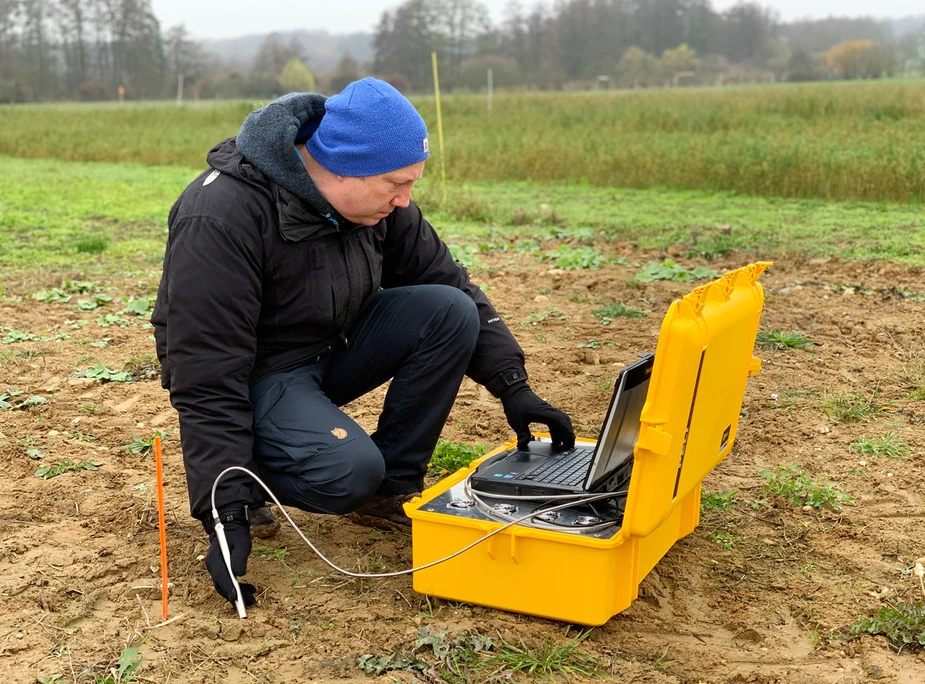Diode lasers meet soil crumbs
Why portable Raman systems are now used in agriculture – the RaMBo measuring system from the Laser Sensors Lab at the Ferdinand-Braun-Institut in Adlershof
Last November, it was finally done. The RaMBo measuring system was deployed for the first time on a field in Potsdam-Marquardt. Its goal: to determine the nutrient content of the soil. Phosphorus and nitrogen, in particular, have an impact on how well plants develop. Fertiliser is used where the soil’s natural content is insufficient. This is done in a tailored way, using just the right amount per square metre. This is the idea of precision farming. Doing it in this way helps to save fertiliser, prevents over-fertilisation in soil and groundwater, and gives the plants exactly what they need.
Measurement devices, like the ones developed as part of the RaMBo (short for Raman Messsystem zur ortsspezifischen Bodenanalytik) project, are an important component of this. Don’t be fooled by the warlike name. RaMBo is a very sensitive system. Equipped with a tiny diode laser and sophisticated analytics, it registers the interaction of its lasers with the molecules in the ground. To do so, it makes use of so-called Raman scattering, or Raman effect: Directing a laser of a particular wavelength at a substance excites the molecules within it, making them vibrate. This changes the wavelength of the light scattering back in a specific way – depending on the type of molecule. Using measurements of the spectra, researchers are also able to identify and measure the nutrient’s molecules.
This is harder in practice than it sounds, however, as the physicist Bernd Sumpf points out. He is the head of the Laser Sensors Lab at the Ferdinand-Braun-Institut, Leibniz-Institut für Höchstfrequenztechnik (FBH) in Adlershof, where the RaMBo system was developed. Agricultural soil with its irregular crumbs and diverse mineral and organic components is a difficult terrain, Sumpf explains: “Every grain of sand is different and, in addition to many other elements, the nutrients we are looking for, phosphorus and nitrogen, exist in different chemical compounds.” The measurements can seem all over the place at first glance and not at all easy to interpret.
Before the system can routinely deliver the desired data, researchers and developers remain involved in a great deal of detective work—searching for clues not only in the soil but particularly in the spectrum. To this end, the various relevant substances and nutrients are analysed in a laboratory to serve as references, which are then used to find specific patterns in the spectra.
“The most exciting thing about it is that so many different disciplines are working together on this,” says Bernd Sumpf. Funded by the Federal Ministry for Education and Research, RaMBo was developed as part of the BONARES programme, which is planned for nine years and has been running for six. The sub-project “I4S – Intelligence for Soil” is being run by the Leibniz Institute for Agricultural Engineering and Bioeconomy in Potsdam-Bornim. Eight additional partners from diverse disciplines are on board too.
Sumpf’s team has successfully tackled an additional challenge that working on farmland entails: “Daylight and other outside influences that produce light also make our analyses more difficult. Additionally, Raman scattering is a very weak effect,” says the physicist. For this reason, the FBH went with a variant of classic Raman spectroscopy: SERDS (Shifted excitation Raman difference spectroscopy). To cause molecule excitation, two slightly different Raman spectra are emitted. This is then reflected in the measured signals and any disruption can be accounted for.
“Our diode lasers are unique for application in Raman spectroscopy because they have two switchable resonators on one chip,” says Sumpf. Earlier experiments have shown that this laser was suitable for measuring leaves and fruit outdoors. For the use on soil, this key element was integrated into a pen-shaped probe that features transfer optics for emitting and collecting light. This is complemented by matching analytics in hard and software. Researchers now have a full case of measurement devices at their disposal for further assignments on agricultural soil.
It is planned to later mount the system on to a vehicle—adding other analysis technologies like near-infrared spectroscopy or conductivity measurement—and pulling it across the field, while the samples are analysed automatically. Using the RaMBo System, the aim is to create a complete package of hard and software that can give out tailored recommendations on fertilisation and irrigation.
By Dr. Uta Deffke for Potenzial – The WISTA Magazine
